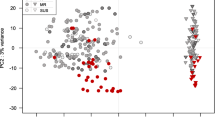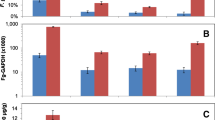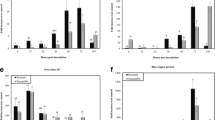Abstract
In many plant/pathogen interactions, host susceptibility factors are key determinants of disease development promoting pathogen growth and spreading in plant tissues. In the Fusarium head blight (FHB) disease, the molecular basis of wheat susceptibility is still poorly understood while it could provide new insights into the understanding of the wheat/Fusarium graminearum (Fg) interaction and guide future breeding programs to produce cultivars with sustainable resistance. To identify the wheat grain candidate genes, a genome-wide gene expression profiling was performed in the French susceptible wheat cultivar, Recital. Gene-specific two-way ANOVA of about 40 K transcripts at five grain developmental stages identified 1309 differentially expressed genes. Out of these, 536 were impacted by the Fg effect alone. Most of these Fg-responsive genes belonged to biological and molecular functions related to biotic and abiotic stresses indicating the activation of common stress pathways during susceptibility response of wheat grain to FHB. This analysis revealed also 773 other genes displaying either specific Fg-responsive profiles along with grain development stages or synergistic adjustments with the grain development effect. These genes were involved in various molecular pathways including primary metabolism, cell death, and gene expression reprogramming. An increasingly complex host response was revealed, as was the impact of both Fg infection and grain ontogeny on the transcription of wheat genes. This analysis provides a wealth of candidate genes and pathways involved in susceptibility responses to FHB and depicts new clues to the understanding of the susceptibility determinism in plant/pathogen interactions.





Similar content being viewed by others
References
Amor Y, Chevion M, Levine A (2000) Anoxia pretreatment protects soybean cells against H(2)O(2)-induced cell death: possible involvement of peroxidases and of alternative oxidase. FEBS Lett 477:175–180
Ashraf M (2014) Stress-induced changes in wheat grain composition and quality. Crit Rev Food Sci Nutr 54:1576–1583. doi:10.1080/10408398.2011.644354
Bergmann DC, Fleming AJ (2010) From molecule to model, from environment to evolution: an integrated view of growth and development. Curr Opin Plant Biol 13:1–4. doi:10.1016/j.pbi.2009.12.001
Bernardo A, Bai G, Guo P et al (2007) Fusarium graminearum-induced changes in gene expression between Fusarium head blight-resistant and susceptible wheat cultivars. Funct Integr Genomics 7:69–77. doi:10.1007/s10142-006-0028-1
Bogorad L, Gubbins EJ, Krebbers E et al (1983) Cloning and physical mapping of maize plastid genes. Methods Enzymol 97C:524–554. doi:10.1016/0076-6879(83)97160-4
Bouarab K, Melton R, Peart J et al (2002) A saponin-detoxifying enzyme mediates suppression of plant defences. Nature 418:889–892. doi:10.1038/nature00950
Boutigny A-L, Richard-Forget F, Barreau C (2008) Natural mechanisms for cereal resistance to the accumulation of Fusarium trichothecenes. Eur J Plant Pathol 121:411–423. doi:10.1007/s10658-007-9266-x
Brauc S, De Vooght E, Claeys M et al (2012) Overexpression of arginase in Arabidopsis thaliana influences defence responses against Botrytis cinerea. Plant Biol 1:39–45. doi:10.1111/j.1438-8677.2011.00520.x
Brenchley R, Spannagl M, Pfeifer M et al (2012) Analysis of the bread wheat genome using whole-genome shotgun sequencing. Nature 491:705–710. doi:10.1038/nature11650
Brewer HC, Hawkins ND, Hammond-Kosack KE (2014) Mutations in the Arabidopsis homoserine kinase gene DMR1 confer enhanced resistance to F. culmorum and F. graminearum. BMC Plant Biol 14:317. doi:10.1186/s12870-014-0317-0
Buerstmayr H, Steiner B, Hartl L et al (2003) Molecular mapping of QTLs for Fusarium head blight resistance in spring wheat. II. Resistance to fungal penetration and spread. Theor Appl Genet 107:503–508. doi:10.1007/s00122-003-1272-6
Cantu D, Vicente AR, Greve LC et al (2008) The intersection between cell wall disassembly, ripening, and fruit susceptibility to Botrytis cinerea. Proc Natl Acad Sci U S A 105:859–864. doi:10.1073/pnas.0709813105
Capron D, Mouzeyar S, Boulaflous A et al (2012) Transcriptional profile analysis of E3 ligase and hormone-related genes expressed during wheat grain development. BMC Plant Biol 12:35. doi:10.1186/1471-2229-12-35
Chandran D, Inada N, Hather G et al (2010) Laser microdissection of Arabidopsis cells at the powdery mildew infection site reveals site-specific processes and regulators. Proc Natl Acad Sci 107:460–465. doi:10.1073/pnas.0912492107
Chandran D, Rickert J, Cherk C et al (2013) Host cell ploidy underlying the fungal feeding site is a determinant of powdery mildew growth and reproduction. Mol Plant-Microbe Interact 26:537–545. doi:10.1094/MPMI-10-12-0254-R
Chetouhi C, Bonhomme L, Lecomte P et al (2015) A proteomics survey on wheat susceptibility to Fusarium head blight during grain development. Eur J Plant Pathol 141:407–418. doi:10.1007/s10658-014-0552-0
Chu Z, Yuan M, Yao J et al (2006) Promoter mutations of an essential gene for pollen development result in disease resistance in rice. Genes Dev 20:1250–1255. doi:10.1101/gad.1416306
Coleman J, Blake-Kalff M, Davies E (1997) Detoxification of xenobiotics by plants: chemical modification and vacuolar compartmentation. Trends Plant Sci 2:144–151. doi:10.1016/S1360-1385(97)01019-4
Conesa A, Götz S, García-Gómez JM et al (2005) Blast2GO: a universal tool for annotation, visualization and analysis in functional genomics research. Bioinforma Oxf Engl 21:3674–3676. doi:10.1093/bioinformatics/bti610
Deeken R, Engelmann JC, Efetova M et al (2006) An integrated view of gene expression and solute profiles of Arabidopsis tumors: a genome-wide approach. Plant Cell 18:3617–3634. doi:10.1105/tpc.106.044743
Desmond OJ, Manners JM, Stephens AE et al (2008) The Fusarium mycotoxin deoxynivalenol elicits hydrogen peroxide production, programmed cell death and defence responses in wheat. Mol Plant Pathol 9:435–445. doi:10.1111/j.1364-3703.2008.00475.x
Diamond M, Reape TJ, Rocha O et al (2013) The Fusarium mycotoxin deoxynivalenol can inhibit plant apoptosis-like programmed cell death. PLoS ONE 8, e69542. doi:10.1371/journal.pone.0069542
Ding L, Xu H, Yi H et al (2011) Resistance to hemi-biotrophic F. graminearum infection is associated with coordinated and ordered expression of diverse defense signaling pathways. PLoS ONE 6, e19008. doi:10.1371/journal.pone.0019008
Dornez E, Croes E, Gebruers K et al (2010) 2-D DIGE reveals changes in wheat xylanase inhibitor protein families due to Fusarium graminearum DeltaTri5 infection and grain development. Proteomics 10:2303–2319. doi:10.1002/pmic.200900493
Eichmann R, Bischof M, Weis C et al (2010) BAX INHIBITOR-1 is required for full susceptibility of barley to powdery mildew. Mol Plant Microbe Interact 23:1217–1227. doi:10.1094/MPMI-23-9-1217
Erayman M, Turktas M, Akdogan G et al (2015) Transcriptome analysis of wheat inoculated with Fusarium graminearum. Front Plant Sci 20:867. doi:10.3389/fpls.2015.00867
Evers T, Millar S (2002) Cereal grain structure and development: some implications for quality. J Cereal Sci 36:261–284. doi:10.1006/jcrs.2002.0435
Gardiner DM, Kazan K, Manners JM (2009) Nutrient profiling reveals potent inducers of trichothecene biosynthesis in Fusarium graminearum. Fungal Genet Biol 46:604–613. doi:10.1016/j.fgb.2009.04.004
Gardiner DM, Kazan K, Praud S et al (2010) Early activation of wheat polyamine biosynthesis during Fusarium head blight implicates putrescine as an inducer of trichothecene mycotoxin production. BMC Plant Biol 10:289. doi:10.1186/1471-2229-10-289
Gervais L, Dedryver F, Morlais J-Y et al (2003) Mapping of quantitative trait loci for field resistance to Fusarium head blight in an European winter wheat. Theor Appl Genet 106:961–970. doi:10.1007/s00122-002-1160-5
Giménez MJ, Pistón F, Atienza SG (2011) Identification of suitable reference genes for normalization of qPCR data in comparative transcriptomics analyses in the Triticeae. Planta 233:163–173. doi:10.1007/s00425-010-1290-y
Golkari S, Gilbert J, Prashar S, Procunier JD (2007) Microarray analysis of Fusarium graminearum-induced wheat genes: identification of organ-specific and differentially expressed genes. Plant Biotechnol J 5:38–49. doi:10.1111/j.1467-7652.2006.00213.x
González-Lamothe R, El Oirdi M, Brisson N, Bouarab K (2012) The conjugated auxin indole-3-acetic acid-aspartic acid promotes plant disease development. Plant Cell 24:762–777. doi:10.1105/tpc.111.095190
Gunnaiah R, Kushalappa AC, Duggavathi R et al (2012) Integrated metabolo-proteomic approach to decipher the mechanisms by which wheat QTL (Fhb1) contributes to resistance against Fusarium graminearum. PLoS ONE 7, e40695. doi:10.1371/journal.pone.0040695
Hershko A, Ciechanover A (1998) The ubiquitin system. Annu Rev Biochem 67:425–479. doi:10.1146/annurev.biochem.67.1.425
Ihara-Ohori Y, Nagano M, Muto S et al (2007) Cell death suppressor Arabidopsis bax inhibitor-1 is associated with calmodulin binding and ion homeostasis. Plant Physiol 143:650–660. doi:10.1104/pp.106.090878
Ishiga Y, Upplapapti S, Mysore KS (2013) Expression analysis reveals a role for hydrophobic or epicuticular wax signals in pre-penetration structure formation of Phakopsora pachyrhizi. Plant Signal Behav 8, e26959. doi:10.4161/psb.26959
Ito M, Sato I, Ishizaka M et al (2013) Bacterial cytochrome P450 system catabolizing the Fusarium toxin deoxynivalenol. Appl Environ Microbiol 79:1619–1628. doi:10.1128/AEM.03227-12
Jia H, Millett BP, Cho S et al (2011) Quantitative trait loci conferring resistance to Fusarium head blight in barley respond differentially to Fusarium graminearum infection. Funct Integr Genomics 11:95–102. doi:10.1007/s10142-010-0192-1
Jubault M, Lariagon C, Taconnat L et al (2013) Partial resistance to clubroot in Arabidopsis is based on changes in the host primary metabolism and targeted cell division and expansion capacity. Funct Integr Genomics 13:191–205. doi:10.1007/s10142-013-0312-9
Koch KE, Ying Z, Wu Y, Avigne WT (2000) Multiple paths of sugar-sensing and a sugar/oxygen overlap for genes of sucrose and ethanol metabolism. J Exp Bot 51 Spec No:417–427
Kong L, Anderson JM, Ohm HW (2005) Induction of wheat defense and stress-related genes in response to Fusarium graminearum. Genome 48:29–40. doi:10.1139/g04-097
Kugler KG, Siegwart G, Nussbaumer T et al (2013) Quantitative trait loci-dependent analysis of a gene co-expression network associated with Fusarium head blight resistance in bread wheat (Triticum aestivum L.). BMC Genomics 14:728. doi:10.1186/1471-2164-14-728
La Camera S, Balagué C, Göbel C et al (2009) The Arabidopsis patatin-like protein 2 (PLP2) plays an essential role in cell death execution and differentially affects biosynthesis of oxylipins and resistance to pathogens. Mol Plant-Microbe Interact 22:469–481. doi:10.1094/MPMI-22-4-0469
Lapin D, Van den Ackerveken G (2013) Susceptibility to plant disease: more than a failure of host immunity. Trends Plant Sci 18:546–554. doi:10.1016/j.tplants.2013.05.005
Lemmens M, Scholz U, Berthiller F et al (2005) The ability to detoxify the mycotoxin deoxynivalenol colocalizes with a major quantitative trait locus for Fusarium head blight resistance in wheat. Mol Plant-Microbe Interact 18:1318–1324. doi:10.1094/MPMI-18-1318
Li Z, Zhou M, Zhang Z, Ren L et al (2011) Expression of a radish defensin in transgenic wheat confers increased resistance to Fusarium graminearum and Rhizoctonia cerealis. Funct Integr Genomics 111:63–70. doi:10.1007/s10142-011-0211-x
Limin AE, Fowler DB (1985) Cold hardness in Triticum and Aegilops species. Can J Plant Sci 65:71–77. doi:10.4141/cjps85-010
Ma H-X, Bai G-H, Gill BS, Hart LP (2006) Deletion of a chromosome arm altered wheat resistance to Fusarium head blight and deoxynivalenol accumulation in Chinese spring. Plant Dis 90:1545–1549. doi:10.1094/PD-90-1545
MacNicol PK, Jacobsen JV (2001) Regulation of alcohol dehydrogenase gene expression in barley aleurone by gibberellin and abscisic acid. Physiol Plant 111:533–539
McMullen M, Jones R, Gallenberg D (1997) Scab of wheat and barley: a re-emerging disease of devastating impact. Plant Dis 81:1340–1348
Nadaud I, Girousse C, Debiton C et al (2010) Proteomic and morphological analysis of early stages of wheat grain development. Proteomics 10:2901–2910. doi:10.1002/pmic.200900792
Pathuri IP, Reitberger IE, Hückelhoven R, Proels RK (2011) Alcohol dehydrogenase 1 of barley modulates susceptibility to the parasitic fungus Blumeria graminis f.sp. hordei. J Exp Bot 62:3449–3457. doi:10.1093/jxb/err017
Pavan S, Jacobsen E, Visser RGF, Bai Y (2010) Loss of susceptibility as a novel breeding strategy for durable and broad-spectrum resistance. Mol Breed 25:1–12. doi:10.1007/s11032-009-9323-6
Pfaffl MW (2001) A new mathematical model for relative quantification in real-time RT-PCR. Nucleic Acids Res 29, e45
Poppenberger B, Berthiller F, Lucyshyn D et al (2003) Detoxification of the Fusarium mycotoxin deoxynivalenol by a UDP-glucosyltransferase from Arabidopsis thaliana. J Biol Chem 278:47905–47914. doi:10.1074/jbc.M307552200
Rogers SO, Bendich AJ (1994) Extraction of total cellular DNA from plants, algae and fungi. In: Gelvin SB, Schilperoort RA (eds) Plant molecular biology manual. Springer, Netherlands, pp 183–190
Schweiger W, Boddu J, Shin S et al (2010) Validation of a candidate deoxynivalenol-inactivating UDP-glucosyltransferase from barley by heterologous expression in yeast. Mol Plant-Microbe Interact 23:977–986. doi:10.1094/MPMI-23-7-0977
Shen Q-H, Saijo Y, Mauch S et al (2007) Nuclear activity of MLA immune receptors links isolate-specific and basal disease-resistance responses. Science 315:1098–1103. doi:10.1126/science.1136372
Smyth GK (2004) Linear models and empirical bayes methods for assessing differential expression in microarray experiments. Stat Appl Genet Mol Biol 3:1–25. doi:10.2202/1544-6115.1027
Smyth GK, Speed T (2003) Normalization of cDNA microarray data. Methods San Diego Calif 31:265–273
Sugie A, Naydenov N, Mizuno N et al (2006) Overexpression of wheat alternative oxidase gene Waox1a alters respiration capacity and response to reactive oxygen species under low temperature in transgenic Arabidopsis. Genes Genet Syst 81:349–354
Sutton JC (1982) Epidemiology of wheat head blight and maize ear rot caused by Fusarium graminearum. Can J Plant Pathol 4:195–209. doi:10.1080/07060668209501326
Tsuge T, Harimoto Y, Akimitsu K et al (2013) Host-selective toxins produced by the plant pathogenic fungus Alternaria alternata. FEMS Microbiol Rev 37:44–66. doi:10.1111/j.1574-6976.2012.00350.x
Tuite J, Shaner G, Everson RJ (1990) Wheat scab in soft red winter wheat in Indiana in 1986 and its relation to some quality measurements. Plant Dis 74:959–962. doi:10.1094/PD-74-0959
Várallyay É, Giczey G, Burgyán J (2012) Virus-induced gene silencing of Mlo genes induces powdery mildew resistance in Triticum aestivum. Arch Virol 157:1345–1350. doi:10.1007/s00705-012-1286-y
Walter S, Kahla A, Arunachalam C et al (2015) A wheat ABC transporter contributes to both grain formation and mycotoxin tolerance. J Exp Bot 66:2583–2593. doi:10.1093/jxb/erv048
Wan Y, Poole RL, Huttly AK et al (2008) Transcriptome analysis of grain development in hexaploid wheat. BMC Genomics 9:121. doi:10.1186/1471-2164-9-121
Wanous MK, Munkvold JD, Kruse JD et al (2003) Identification of chromosome arms influencing expression of the HMW glutenins in wheat. Theor Appl Genet 106:213–220. doi:10.1007/s00122-002-1098-7
Xiong L, Yang Y (2003) Disease resistance and abiotic stress tolerance in rice are inversely modulated by an abscisic acid–inducible mitogen-activated protein kinase. Plant Cell 15:745–759. doi:10.1105/tpc.008714
Yang F, Li W, Jørgensen HJL (2013) Transcriptional reprogramming of wheat and the hemibiotrophic pathogen Septoria tritici during two phases of the compatible interaction. PLoS ONE 8, e81606. doi:10.1371/journal.pone.0081606
Zhu X, Li Z, Xu H et al (2012) Overexpression of wheat lipid transfer protein gene TaLTP5 increases resistances to Cochliobolus sativus and Fusarium graminearum in transgenic wheat. Funct Integr Genomics 12:481–488. doi:10.1007/s10142-012-0286-z
Acknowledgments
This work is part of CC PhD work, funded by the French National Institute for Agronomic Research (INRA). We thank members of the PHACC unit for plant preparation, and Philippe Lecomte and Cyrille Saintenac for fruitful discussions.
Author information
Authors and Affiliations
Corresponding authors
Electronic supplementary material
Below is the link to the electronic supplementary material.
Fig. S1
Symptoms observed during susceptibility responses to Fg at the 250°Cd developmental stage. (a) and (b) represent control and Fg inoculated ears, (c) and (d) represent control and Fg infected grains, respectively. (PDF 60 kb)
Fig. S2
Check up on the microarray data by qRT-PCR. Micro-array (blue) and quantitative RT-PCR (red) data are expressed in a log2 ratio obtained for comparison between Fg-inoculated and control plants at three time points (250°Cd, 350°Cd and 450°Cd). (PDF 57 kb)
ESM 3
(XLSX 17429 kb)
ESM 4
(XLSX 75 kb)
ESM 5
(XLSX 8 kb)
ESM 6
(XLSX 60 kb)
ESM 7
(XLSX 39 kb)
ESM 8
(XLSX 19 kb)
ESM 9
(XLSX 61 kb)
Rights and permissions
About this article
Cite this article
Chetouhi, C., Bonhomme, L., Lasserre-Zuber, P. et al. Transcriptome dynamics of a susceptible wheat upon Fusarium head blight reveals that molecular responses to Fusarium graminearum infection fit over the grain development processes. Funct Integr Genomics 16, 183–201 (2016). https://doi.org/10.1007/s10142-016-0476-1
Received:
Revised:
Accepted:
Published:
Issue Date:
DOI: https://doi.org/10.1007/s10142-016-0476-1




